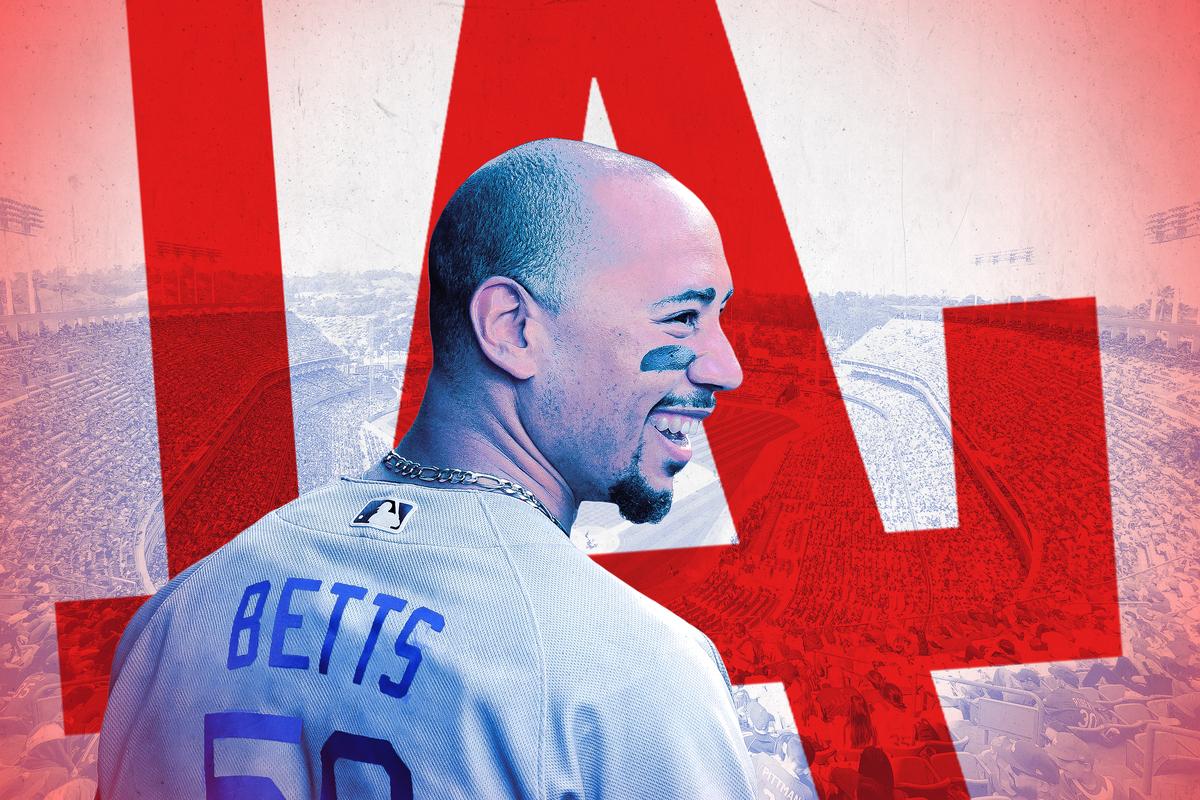
The Dodgers don’t sign stars in free agency. With Andrew Friedman in charge of the roster, L.A.’s largest signing of an outside player has been A.J. Pollock last winter, to the relatively piddly amount of four years and $55 million.
But the Dodgers do trade for stars. Yu Darvish came to L.A. at the 2017 trade deadline, before the club made and lost in the World Series. Manny Machado joined the team at the deadline in 2018, before the same postseason scenario arose. And on Tuesday, in the greatest swoop of all, L.A. plucked Mookie Betts out of Fenway Park and brought him to Dodger Stadium.
The Dodgers don’t automatically advance to the World Series with this acquisition, and they certainly haven’t won one yet. (As their fans are well aware, it’s been more than three decades since.) But the Dodgers projected as the National League’s best team before Tuesday, and then they added one of the very best players in the sport.
The full reported trade (according to ESPN’s Jeff Passan and Kiley McDaniel) is a costly splurge and a win-now gamble, as the Dodgers ship out young outfielder Alex Verdugo and pitcher Kenta Maeda to acquire Betts, a free agent next winter, and expensive pitcher David Price. (In a separate deal, they reshuffled the roster’s depth by sending outfielder Joc Pederson down south in exchange for Angels infielder Luis Rengifo.) It’s also totally worth the minimal risk, a home run of a transaction that makes the Dodgers better, more competitive, and worlds more fun this season.
It’s hard to know where to start in praising Betts, but a comprehensive statement for a comprehensive star will do: Aside from Mike Trout, Betts has a strong case for the best player in baseball. He beat Trout for AL MVP in 2018, finished runner-up to the Angels outfielder in 2016, and even in his “down” seasons of 2017 and 2019 still finished in the top 10 of MVP voting.
Betts might never again craft a slash line 85 percent better than league average, as he did in his indomitable 2018 campaign, which ended in a Boston title against L.A. (It’s worth a parenthetical note that the Red Sox might have illicitly stolen signs that season.) But even if he’s closer to 35 percent better, as he was last season, he still might rank second only to Trout. Since 2016, Betts has been worth 33.8 bWAR, close to the leading Angel and well ahead of third-place Nolan Arenado, who is as close to 29th place as he is to Betts.
Top Position Player WAR, 2016-19
That’s because in addition to his lightning-quick bat, Betts offers tremendous durability, baserunning, and outfield defense. He’s a true five-tool player with no need for exaggerating or twisting the definition of the term. On defense, he’s won a Gold Glove four years in a row, ranking first among all fielders at any position in that span in both prominent advanced defensive stats (UZR and DRS). Through his age-26 season, Betts has been worth 42 career WAR, per Baseball-Reference—one spot ahead of Barry Bonds on the all-time leaderboard through that age, two spots ahead of Willie Mays.
So yes, that collection of skills is one the Dodgers would want in their lineup. Betts offered one of the only possible upgrades, actually, to a club with so much depth that its “replacement level” is much higher than replacement level across the league. It would have taken a true star to improve upon L.A.’s internal options—and Betts indeed fits that descriptor.
He joins a lineup already studded with stars, from Cody Bellinger—the reigning NL MVP, who will join Betts in a galactic outfield—to Max Muncy to Corey Seager and more. Not counting pitchers batting, the Dodgers have been the best or second-best team by wRC+ in each of the last three seasons, and now they add a top-of-the-lineup force with a nearly unmatched combination of power and on-base ability.
Moreover, Betts makes Verdugo expendable, given the Dodgers’ crowded outfield; in the same vein, Price fills Maeda’s role in the rotation and, if he’s healthy, might even represent an upgrade from the departed Dodger. It was only two seasons ago that Price won the clinching World Series game in Dodger Stadium, after all. L.A. thus added Betts without sacrificing any fraction of their 2020 contention plans or a single prospect from their rich farm system. Read that sentence again—and, if you’re a Dodgers fan, skip the rest of this article because it’s time to celebrate.
One cold, calculating perspective might say the Dodgers gave up more surplus value in the deal than they returned. Maeda is a valuable player on a team-friendly contract; Verdugo has five years of club control remaining, most or all of them cheap as he works his way through arbitration. Betts, meanwhile, can bolt in free agency after this season, and he’ll earn $27 million this year, which is why Boston felt the (immensely foolish) need to trade him at all. The Dodgers also must commit a hefty amount of money to Price, who has three years and $96 million left on his contract, has been hurt two of the last three years, and just suffered through his worst season in a decade.
Yet that perspective would be extreme to the point of parody. Sure, Verdugo—a useful outfielder in his own right, though nowhere near Betts as a talent—might be worth more wins over the course of his control than Betts is in 2020 alone. But a win now is worth more than a win later, and the Dodgers’ player-development machine can churn out another half-dozen Verdugos in the next few years. The Bettses of the sport are not so fungible, and given his production, he’s an utter bargain at only $27 million per year.
Mookie Betts Career Production in Dollars Per WAR
That only an outlandish sabermetric straw man might object to this trade for any reason is proof of how well the Dodgers make out here. It’s impossible to find any flaws in their logic or execution. Heck, with all the money they make and with how low their payroll had dipped this winter, they would have been just fine paying extra for Betts—and they even managed to convince Boston to throw in some money to help pay down Price’s contract, too.
Even as the Diamondbacks project to improve this season and the Padres move on the upswing with a potpourri of prospects matriculating to the majors, the Dodgers shouldn’t face much pressure as they seek their eighth consecutive division title. Before acquiring Betts, the Dodgers—who won 106 games last season and barely lost any contributors this winter—already looked like the clear NL West favorite. But in each of their previous seven trips to the postseason during this run, they fell short of the trophy; this trade is about the playoffs, and the final prize that has eluded the franchise for so long.
Betts might not make the difference in October; celebrated acquisitions Darvish and Machado failed to before. It’s hard to separate a good player from a great one over the small sample of the postseason. But Betts stuffs the Dodgers’ lineup in frightening fashion, even beyond what the club has boasted before, and he gives the club versatility and the fans another shining star to cheer.
Beyond the baseball aspect, beyond the potential October lineup configurations, that’s the final part of this trade that should delight the Dodgers fan base. They get to watch Betts play every day, even if for only a year before he commands a $300 million–plus payment next winter. Just ask Boston fans how much entertainment he brings. Or don’t, because they’re too busy lamenting the star who got away.

